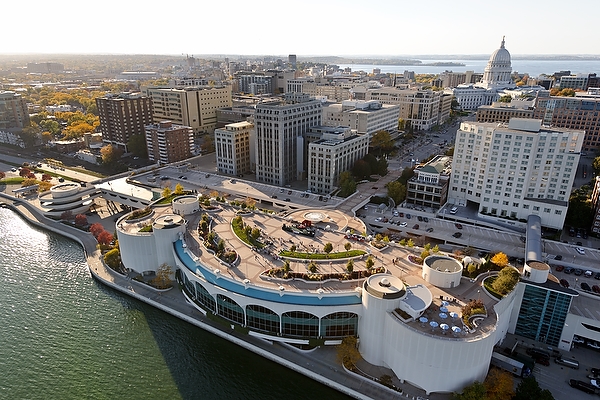SSEC, CIMSS co-organize American Meteorological Society conference in Madison
Partnering with UW-Madison organizers, the American Meteorological Society (AMS) is sponsoring a meeting at the Monona Terrace in Madison, Wisconsin, the week of 15-19 August 2016. With oversight provided by two AMS committees, the Joint 21st Satellite Meteorology, Oceanography and Climatology Conference and 20th Conference on Air-Sea Interaction will bring together scientists from a variety of fields to present on and discuss important, interdisciplinary research and results.
Steve Ackerman, director for the Cooperative Institute for Meteorological Satellite Studies (CIMSS), and CIMSS scientist Jordan Gerth teamed up with the NASA Jet Propulsion Laboratory’s Derek Posselt to organize the Satellite Meteorology, Oceanography and Climatology portion of the meeting, which the AMS sponsors every 18 months—either in conjunction with the AMS annual meeting or by partnering with another organization. This allows both groups to cut costs, increase attendance, and foster cross-disciplinary collaboration.
The decision to host the meeting in Madison this year was no accident.
“The fact that Madison is the birthplace of meteorological satellites makes it a fitting place for this meeting,” says Ackerman, referring to University of Wisconsin-Madison professors and Space Science and Engineering Center (SSEC) co-founders Verner Suomi and Robert Parent, who led the development of the first successful spaceborne meteorological instrument in 1959.
SSEC and CIMSS scientists will be well-represented at the meeting, says Gerth, with dozens scheduled to present abstracts, chair sessions, show posters, and demonstrate various technologies in a special SSEC exhibit hall.
“This shows the dominant role we play in the field of satellite meteorology,” says Ackerman, noting that both SSEC and CIMSS play active roles in the GOES-R and JPSS missions: next-generation U.S. satellites set to launch in 2016 and 2017, respectively.
Attendees should expect to encounter cutting-edge research—next-generation satellite systems, satellite data re-processing and integration methods, and research-to-operations applications, to name a few areas of interest—as well as a few twists.
For example, over the lunch hours Tuesday through Thursday, the organizers have scheduled forums called “community conversations,” during which attendees may bring up and discuss pertinent issues, such as (but not limited to) nano- and micro-satellites, user readiness, and the NASA decadal survey.
“What we are trying to achieve with the community conversations is an open dialogue—we are not letting anybody bring slides. They can ask questions; they can state their opinion; it’s essentially open microphone. We really want to keep it interactive,” explains Gerth.
He hopes that everyone will attend, particularly scientists who may not have had many other opportunities to voice their thoughts and opinions.
“Everybody is invited,” says Gerth. “It’s not necessarily just for higher level community members, people who have previously been involved in some of these topics, who get a chance to say something. It’s really anybody who has an interest.”
Ackerman is most looking forward to the two “State of the Science” keynote addresses that will open the meeting, saying he expects both to be “very engaging.” Hisashi Nakamura from the University of Tokyo will present on sea-surface temperatures, and Steve Miller from Colorado State University will discuss recent advances in the VIIRS day/night band.
“I think these two talks will generate a lot of conversation about the work being done by these two groups,” says Ackerman.
From its iconic lakes (Mendota, Monona, and Wingra) to the farmers’ market on the Capitol Square, Madison is a picturesque place to both host and attend a conference—especially at this time of year.
“I think if people had their druthers they would want to come back here,” Ackerman says, “not just because of the satellite meteorology connection, but because Madison is such a great city.”

